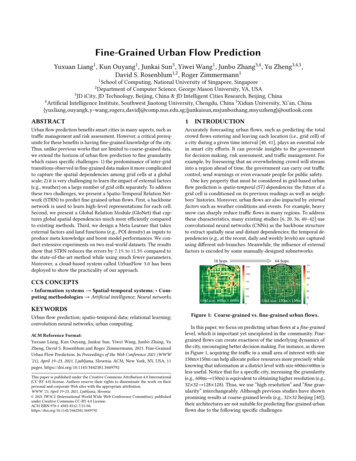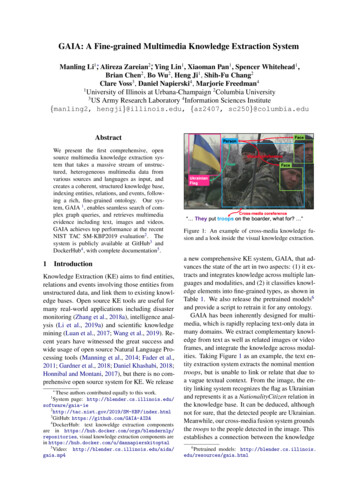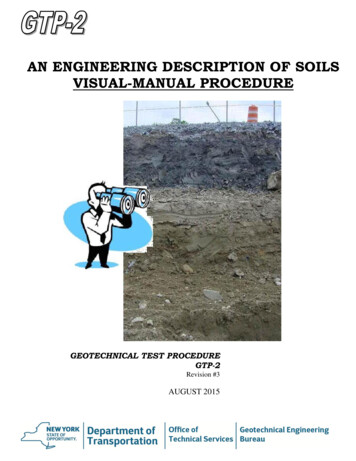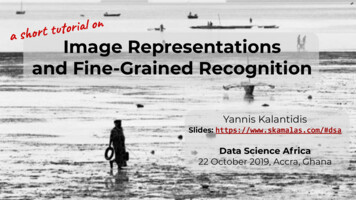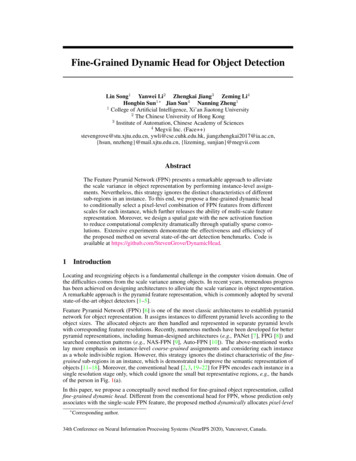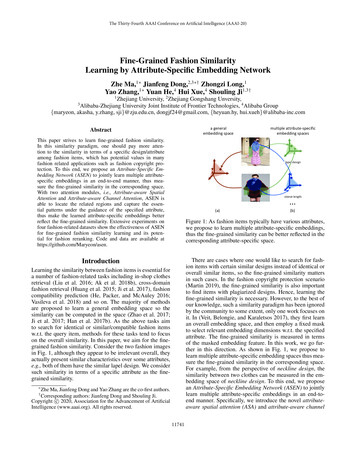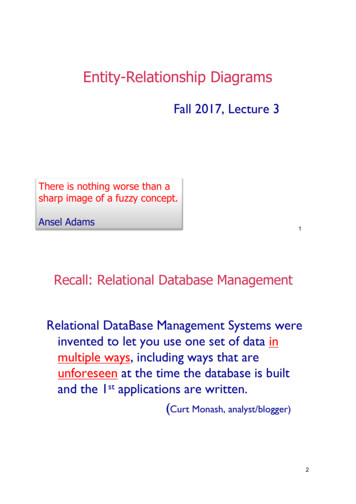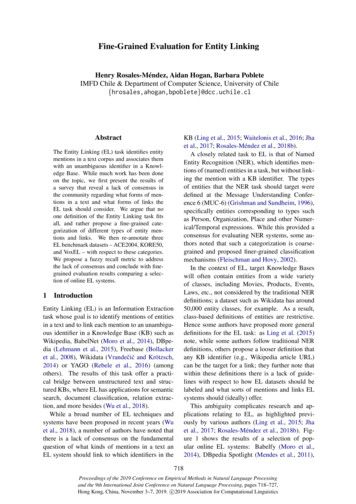
Transcription
Fine-Grained Evaluation for Entity LinkingHenry Rosales-Méndez, Aidan Hogan, Barbara PobleteIMFD Chile & Department of Computer Science, University of actKB (Ling et al., 2015; Waitelonis et al., 2016; Jhaet al., 2017; Rosales-Méndez et al., 2018b).A closely related task to EL is that of NamedEntity Recognition (NER), which identifies mentions of (named) entities in a task, but without linking the mention with a KB identifier. The typesof entities that the NER task should target weredefined at the Message Understanding Conference 6 (MUC-6) (Grishman and Sundheim, 1996),specifically entities corresponding to types suchas Person, Organization, Place and other Numerical/Temporal expressions. While this provided aconsensus for evaluating NER systems, some authors noted that such a categorization is coarsegrained and proposed finer-grained classificationmechanisms (Fleischman and Hovy, 2002).In the context of EL, target Knowledge Baseswill often contain entities from a wide varietyof classes, including Movies, Products, Events,Laws, etc., not considered by the traditional NERdefinitions; a dataset such as Wikidata has around50,000 entity classes, for example. As a result,class-based definitions of entities are restrictive.Hence some authors have proposed more generaldefinitions for the EL task: as Ling et al. (2015)note, while some authors follow traditional NERdefinitions, others propose a looser definition thatany KB identifier (e.g., Wikipedia article URL)can be the target for a link; they further note thatwithin these definitions there is a lack of guidelines with respect to how EL datasets should belabeled and what sorts of mentions and links ELsystems should (ideally) offer.This ambiguity complicates research and applications relating to EL, as highlighted previously by various authors (Ling et al., 2015; Jhaet al., 2017; Rosales-Méndez et al., 2018b). Figure 1 shows the results of a selection of popular online EL systems: Babelfy (Moro et al.,2014), DBpedia Spotlight (Mendes et al., 2011),The Entity Linking (EL) task identifies entitymentions in a text corpus and associates themwith an unambiguous identifier in a Knowledge Base. While much work has been doneon the topic, we first present the results ofa survey that reveal a lack of consensus inthe community regarding what forms of mentions in a text and what forms of links theEL task should consider. We argue that noone definition of the Entity Linking task fitsall, and rather propose a fine-grained categorization of different types of entity mentions and links. We then re-annotate threeEL benchmark datasets – ACE2004, KORE50,and VoxEL – with respect to these categories.We propose a fuzzy recall metric to addressthe lack of consensus and conclude with finegrained evaluation results comparing a selection of online EL systems.1IntroductionEntity Linking (EL) is an Information Extractiontask whose goal is to identify mentions of entitiesin a text and to link each mention to an unambiguous identifier in a Knowledge Base (KB) such asWikipedia, BabelNet (Moro et al., 2014), DBpedia (Lehmann et al., 2015), Freebase (Bollackeret al., 2008), Wikidata (Vrandečić and Krötzsch,2014) or YAGO (Rebele et al., 2016) (amongothers). The results of this task offer a practical bridge between unstructured text and structured KBs, where EL has applications for semanticsearch, document classification, relation extraction, and more besides (Wu et al., 2018).While a broad number of EL techniques andsystems have been proposed in recent years (Wuet al., 2018), a number of authors have noted thatthere is a lack of consensus on the fundamentalquestion of what kinds of mentions in a text anEL system should link to which identifiers in the718Proceedings of the 2019 Conference on Empirical Methods in Natural Language Processingand the 9th International Joint Conference on Natural Language Processing, pages 718–727,Hong Kong, China, November 3–7, 2019. c 2019 Association for Computational Linguistics
FRED (Gangemi et al., 2017) and TagME (Ferragina and Scaiella, 2010). We see significant differences in the annotations provided, which we argue are due not only to differing precision/recallof the systems, but also to differing policies on issues such as overlapping entities (should “MichaelJackson” be annotated within the documentary title), common/named entities (should “interview”be linked to the corresponding Wikipedia articlewiki:Interview), and more besides. With suchvarying perspectives on the EL task, it is not clearhow we should define gold standards that offer afair comparison of tools (Ling et al., 2015).The standard approach to tackle this issue hasbeen to make certain design choices explicit, suchas to enforce a particular policy with respect tooverlapping mentions, or common entities, etc.,when labeling an EL dataset or performing evaluation. However, the appropriate policy may dependon the particular application, setting, etc. In thispaper we pursue an alternative approach, which isto embrace different perspectives of the EL task,proposing a fine-grained categorization of different types of EL mentions and links, and then reannotating three existing datasets with respect tothese categories, allowing us to compare the performance of EL tools within the different categories. Specifically, our contributions are as follows (indicating also the relevant section):In an [interview]td with [Martin Bashir]btf forthe 2003 [documentary]td [Living with {MichaelJackson}bd ]btf , the King of [Pop]d recalled that[Joe]t often sat with a white belt at hand as heand his four [siblings]td rehearsed.Figure 1: Output annotations made by four differentsystems – Babelfy (b), TagME (t), DBpedia Spotlight(d) and FRED (f) – on the same input text.§ 7 We present conclusions about the performance of the EL systems surveyed for different types of entity mentions/links and highlight open challenges for the EL task.2Questionnaire: Lack of ConsensusTo understand what consensus (or lack thereof) exists within the EL community regarding the ELtask, we designed a concise questionnaire withtwo sentences for which we proposed a variety ofEL annotations, providing the text, the annotatedtext mentions, and proposed links to the respectiveWikipedia articles. The two sentences – shown inFigure 2 (with a summary of results that will bedescribed presently) – were designed to exemplifythe types of design choices that vary from authorto author (Ling et al., 2015); specifically, we targetthe following questions:§ 2 We design and present the results of a questionnaire addressed to authors of EL papersintended to understand the consensus (or lackthereof) regarding the goals of the EL task.1. Entity types: should types not typically considered under MUC-6 definitions (other thanas MISC) be linked (e.g., linking Livingwith Michael Jackson to the correspondingWikipedia article)?§ 3 We argue that no one definition of an entity mention/link fits all, and hence proposea fine-grained categorization scheme for theEL task covering details regarding base form,part of speech, overlap, and reference type.2. Overlapping mentions: should mentionsinside other mentions be annotated (e.g.,Michael Jackson)?§ 4 We relabel three existing EL datasets –ACE2004 (subset), KORE50 and VoxEL –per our novel categorization scheme, extending the set of annotations as appropriate.3. Common entities: should common nouns beannotated (e.g., documentary)?4. Parts of speech: should only nouns be annotated or should other parts of speech also belinked (e.g., reports or white)?§ 5 We conduct a fine-grained evaluation of theperformance of five EL systems with respectto individual categories of EL annotations.5. Mention types: should complex types of mentions, such as pronouns (e.g., he) or descriptive noun phrases indicating named entities,be annotated (e.g., linking he and his foursiblings to wiki:The Jackson 5)?§ 6 Addressing the lack of consensus, we propose a fuzzy recall and F1 measure based ona configurable membership function, presenting results for the five EL systems.719
In an [interview].19 with [Martin Bashir]1 for the [2003].28 [documentary].28 [Living with {Michael Jackson}.75 ].97 ,the [{King}.08 of {Pop}.33 ].94 [recalled].06 that [Joe]1 often [sat].08 with a [white].11 [belt].14 at [hand].14 as[{he}.56 and {his}.39 {four}.08 {siblings}.14 ].50 [rehearsed].08 .[Russian].61 [daily].14 [Kommersant].97 [reports].06 that [Moscow].94 will [supply].06 the [Greeks].94 with [gas].36at [{rock}0 bottom {prices}.19 ].28 as [Tsipras].92 [prepares].03 to [meet].06 the [{Russian}.53 {President}.12 ].97 .Figure 2: The sentences included in the questionnaire and the ratio of respondents who suggested to annotate thementions. Multiple links were proposed for the mentions underlined (see Table 1).son (0.97), the vast majority of respondentsdo not restrict to non-MISC MUC types.6. Link types: should mentions link to theexplicitly named entity (e.g., linkingMoscow to wiki:Moscow), or shouldcomplex forms of reference such asmeronymy (e.g., linking Moscow towiki:Government of Russia), hypernymy(e.g., linking daily to wiki:Newspaperas the closest entity present in theKB, or linking Russian President towiki:Vladimir Putin), or metaphor (e.g.,linking King to wiki:King) be considered?2. Overlapping mentions: per Michael Jackson(0.75), most respondents also allow mentionscontained in other mentions.3. Common entities: most respondents do notconsider common entities, with the highestresponse appearing for documentary (0.28).4. Parts of speech: the consensus was mostlythat EL should focus on nouns, with his(0.39) and white (0.11) being the most popularly selected non-nouns.For each sentence, respondents were asked toselect the mentions and links that they consideran EL system should ideally provide; specifically,they were presented an optional multiple choicequestion for each mention: the option to select one(or more, in underlined cases) suggested links, andthe option to not annotate the mention. In order toaddress this survey to the EL research community,we extracted the emails of all papers referenced inthe recent survey by Wu et al. (2018) that are directly related to EL. We sent the questionnaire to321 researchers, of which 232 requests were delivered successfully. We received a total of 36 responses. Aggregated responses are available online1 , where in Figure 2 we provide a summaryof results, indicating in superscript the ratio of respondents who agreed to some link being providedfor the given mention.First we see that the only mentions that all 36respondents agreed should be linked are MartinBashir and Joe, which are traditional MUC types,non-overlapping, named entities, with direct mentions and links; on the other hand, there was alsoconsensus that rock should not be linked. Otherwise, all other mentions showed some level ofdisagreement. Regarding our questions:5. Mention types: here there was a notable split,with he (0.56) and he and his four siblings (0.5)2 being selected for annotation byroughly half of the respondents.6. Link types: for this we introduce Table 1,where we see how respondents preferred different types of reference (respondents couldselect multiple options); from this we conclude that although respondents preferred touse a country directly to represent nationality, they also preferred to resolve complextypes of reference, such as the meronymicuse of Moscow to refer to the governmentrather than the city, and the use of Putin’s titleto refer to him rather than the title itself.So who is correct? We argue that there is no“correct” answer here. Common entities may, forexample, rather be considered the target of a separate Word Sense Disambiguation task (Navigli,2009), while pro-forms may be considered the target of a separate Coreference/Anaphora Resolution task (Sukthanker et al., 2018); these are matters of convention. In more practical terms, the1. Entity types: per Living with Michael Jack1https://users.dcc.uchile.cl/ hrosales/questionnaire2One respondent noted that it was not certain that this referred to The Jackson 5.720
Table 1: Links for mentions with multiple choices inFigure 2 and the ratio of respondents selecting that linkLinkRatio[Russian] daily Kommersantwiki:Russiawiki:Russianswiki:Russian language.0.610.110.083.1The Base Form considers the type of mention: isit a name, a common noun, a number, a date, etc.We separate Proper Noun into more specificcategories that deal with the difference betweenmentions and KB labels: Full Name, ShortName, Extended Name and Alias. The first threeshould be tagged when the mentions are equal(Michael Jackson), shorter (Jackson) or longer(Michael Joseph Jackson), respectively, than theprimary label of their corresponding KB-entity(wiki:Michael Jackson). On the other hand,Alias is used for mentions that vary from the primary label of the KB (King of Pop).Numeric/Temporal are mentions that refer to anumber or a given temporal concept (e.g., 1, 1900,first, October, July 07, Tuesday, 2018/01/32,etc.). Such mentions were included in the MUC6 definition and some such expressions have corresponding Wikipedia articles. The next categoryis Pro-form, which includes any pronoun (he, his,etc.) referring to a named entity elsewhere. Thefinal category is Common Form, which refers to acommon word, such as documentary, sat, etc., ora noun-phrase referring to a named entity with acommon head term, e.g., he and his four siblings. that [Moscow] will supply .wiki:Government of Russia0.77wiki:Moscow0.36. supply the [Greeks] with gas .wiki:Greece0.77wiki:Greeks0.36. the [Russian] President.wiki:Russia0.42wiki:Russians0.19. the [Russian President].wiki:Vladimir Putin0.77wiki:President of Russia0.61importance of each individual EL annotation mayvary from application to application; for example, for relation extraction, it may be importantto identify all repeated mentions of an entity (aseach such mention may lie within a distinct relation), while for semantic search having repeatedmentions may be less critical (a subset of mentionsmay suffice to know the document is relevant fora given entity). We propose that no one definitionof the EL task fits all, and rather propose a categorization that covers different perspectives.3Base Form3.2Part of SpeechPart of Speech denotes the grammatical functionof a word in a sentence, where we include fourhigh-level classes for which we have found instances that could be linked to the Wikipedia KB(without referring to their own syntactic form).As we have already discussed, the most commontarget for EL is Noun Phrases; we divide theseinto Singular and Plural for additional granularity. However, we also include Verbs (e.g., divorcing, metastasized), Adjectives (e.g., anaerobic, French) and Adverbs (e.g., polynomially, Socratically) for linking to the Knowledge Base.Categorization SchemeInspired by the results of the questionnaire andrelated discussion by Ling et al. (2015), amongother authors, in Figure 3 we propose a categorization scheme aiming to capture and organizethese diverse perspectives on the EL task. Thisscheme makes explicit the types of annotations –mention–link pairs – that can be considered whenannotating EL datasets, or when developing, evaluating and applying EL systems. The categorization scheme has four dimensions: Base Form, Partof Speech, Overlap and Reference. We proposethat each EL annotation be labeled with preciselyone leaf-node from each dimension. Our objective with this categorization is not to imply that alltypes of annotations should be considered as partof the EL task, but rather to map out the types ofannotations that could be considered for EL.3.3OverlapThe Overlap dimension, as its name suggests, captures the nature of overlap between mentions. Asan example, for the mention New York City Police Museum, the mention New York would haveMinimal overlap (assuming York is not incorrectlyidentified), New York City Police would have Intermediate overlap, and New York City PoliceMuseum would have Maximal overlap.721
BASE F ORMPART OF S PEECHProper NounOVERLAPNoun PhraseR EFERENCENoneDirectFull NameSingularMaximalAnaphoricShort tended ric/TemporalCommon FormPro-FormFigure 3: EL categorization scheme with concrete alternatives (leaf-nodes) shaded for each dimension3.44ReferenceThe Reference dimension considers the relationbetween the mention and the linked entity. Thetopic of reference is a complex one that hasbeen the subject of much attention over manydecades (Strawson, 1950); here we propose apragmatic but comprehensive set of options.The Direct category considers a direct explicitmention of an entity based on a known KB label/alias, such as M. Jackson or the King ofPop for wiki:Michael Jackson or divorcing forwiki:Divorce. Anaphoric denotes a referenceto an antecedent (or postcedent) for pro-formssuch as he or her that are coreferent with anamed entity. Metaphoric captures figurative references to entities whose characteristics are referred to, such as He is a pool [shark] linkingto wiki:Shark. Metonymic indicates reference bycommon association, such as using Moscow to refer to wiki:Government of Russia or using Peruto refer to wiki:Peru national football team.Related is used when only a near-synonym, hypernym or hyponym is available for a mention in the KB, such as the Russian [daily] being linked to wiki:Newspaper.3 Finally, Descriptive is used for (non-pro, non-proper) referring noun-phrases, such as his father referringto wiki:Joe Jackson; unlike similar Anaphoricreferences, Descriptive references do not necessarily rely on an antecedent to be disambiguated, as per the case of Hendix’s band referring to wiki:The Jimi Hendrix Experience orFiji’s capital referring to wiki:Suva without requiring further context to disambiguate.Fine-Grained DatasetsA wide variety of EL datasets have been proposed (e.g., ACE2004 (Ratinov et al., 2011),KORE50 (Hoffart et al., 2012), MEANTIME (Minard et al., 2016), DBpedia Spotlight (Mendeset al., 2011), VoxEL (Rosales-Méndez et al.,2018a)) to support EL quality measurement. However, often the guidelines followed in the annotation process are left implicit, such as the inclusion/exclusion of overlapping mentions, commonentities, etc. Furthermore, different types of entities are not distinguished.To put our categorization into practice, we select three existing datasets – KORE50, ACE2004,and VoxEL – and categorize each annotation. Wefurther add novel annotations not considered in theoriginal labeling process with the goal of capturingas many potential (categorized) links to Wikipediaarticles as possible. The process of annotation wasdone manually by three authors (with the help ofthe NIFify tool (Rosales-Méndez et al., 2019) forlabeling overlaps, parts of speech, as well as validation). The annotation process was iterative. Thefirst author began an initial annotation based ona strict and relaxed notion of “entity”, with strictreferring to classical definitions of entities, andrelaxed referring to any entity mention linkablewith Wikipedia (following the literature). Thisprocess raised ambiguities regarding metonymicreferences, descriptive noun phrases, etc. Hencethe authors defined fine-grained categories to address ambiguous cases and designed the questionnaire to better understand the community consensus. The first author relabeled the data per thefine-grained categorization, with semi-automatedverification. The other authors then revised theseannotations in detail; there were significant dif-3Wikipedia will often redirect from a term to a related article; for example, wiki:Daily newspaper currently redirectsto wiki:Newspaper.722
Table 2: Content of relabeled datasetsferences, leading to further discussion and refinements in the categorization. Ambiguities and disagreements were iteratively resolved by the authors through discussion and modification of thecategories. The resulting datasets reflect the consensus of the authors. The categorization schemeshown in Figure 3 is also a result of this process, where we iteratively extended and refinedthese categories as we encountered specific casesin these datasets; as a result, these categories suffice to cover all cases of possible mentions ofWikipedia entities in the datasets.The labeling process was extremely time consuming (taking place over six months) due to thelarge number of annotations generated, particularly for common-form mentions; for this reason,in the case of ACE2004, we only annotate 20 documents (from a total of 57) wherein, for example,the number of annotations increases from 108 inthe original data to 3,351 in our fine-grained version4 . Per MUC-6, we also include emerging/notin-lexicon entities and entity types in our annotations. Additionally, we label some mentions withmultiple alternatives (per Table 1).In Table 2 we summarize details of the reconstructed version of these three datasets, including the number of documents, sentences and annotations. Except for the case of ACE2004, ourre-annotated datasets maintain the same text collection as in the original version. For each category, we also show the number of annotationstagged with it. The most frequent annotationsare those that belong to Common Form, SingularNoun, Non-Overlapping and Direct categories.In the final iteration, we perform validationchecking for erroneous links avoiding invalid,redirect and disambiguation pages; erroneous categorizations, e.g., multiple tags in the same category; erroneous mentions, such as trailing spaces;etc. During this process, we also encounteredand resolved numerous issues with the originaldatasets; of note, in ACE2004 we found variousspelling errors of entity names, e.g., Stewart Talbot as a misspelling of Strobe Talbott, Coral Islands as a misspelling of Kuril Islands, ns150372202143,35115941,107Full NameShort NameExtended NameAliasNumeric/TemporalCommon 7–1511161542Singular NounPlural 683182149858No OverlapMaximal OverlapIntermediate OverlapMinimal garding different types of EL annotations. In Table 3, we present the Precision (P), Recall (R) andF1 score (F1 ) for five popular EL systems withonline APIs: Babelfy (B), TagME (T), DBpediaSpotlight (D), AIDA (A) and FREME (F). In thecase of Babelfy, we consider both settings: strict,which excludes common entities (Bs ); and relaxed, which includes common entities (Br ). Results are shown for subsets of annotations corresponding to a particular category (A), where wealso present the number of unique mentions forannotations of that category ( A ). Recall that ourgold standard may have multiple annotations for asingle mention in the gold standard, listing different possible links for an individual mention (see,e.g., Table 1); on the other hand, evaluated systemspredict a single link for each mention. We thusevaluate annotations on a mention-by-mention basis.5 We consider a predicted mention to be a truepositive if it is included in A and the predicted linkFine-Grained EvaluationOur fine-grained datasets allow us to understandthe performance of EL systems in more detail re-54While a mention can only appear in one PART- OF OVERLAP category, it can appear in multipleor R EFERENCE categories for alternative links.SPEECH andBASE F ed EMNLP datasets723
Table 3: Results for Babelfy (strict/relaxed), TagME, DBpedia Spotlight, AIDA and FREME on the unified dataset.Bs A PRFull MentionShort MentionExtended MentionAliasNumeric/TemporalCommon 450.210Singular NounPlural pingMaximal OverlapIntermediate OverlapMinimal 460.59corresponds to any of the possible links given byA for that mention. We consider a predicted mention to be a false positive if the mention is givenby A, but the predicted link is not given by A forthat mention; in other words, when restricting Aby category, system annotations on mentions outside of A are ignored.6 Finally we consider a mention to be a false negative if it is given by A buteither the mention is not predicted by the systemor the system predicts a link not given by A fortht mention. We also show the overall result in thefinal row considering the full gold standard. Theresults consider a unified dataset that concatenatesall three datasets. Better results (closer to 1) areshaded darker to aid with visual comparison.Comparing the different types of annotations,on a high-level, we can see that recall, in particular, varies widely across categories; unsurprisinglyperhaps, systems, in general, exhibit higher recallfor proper nouns (particularly full and extendednames) with direct references. Looking at categories with poor results, we see that none of theevaluated systems consider anaphoric references,perhaps considered as a task distinct from EL. Interestingly, no system captures metonymic references, though as previously seen the results of ourquestionnaire (see Table 1) indicate that respondents prefer such types of links over their literalcounterparts (e.g., linking Moscow in the .770.160.260.720.140.24context with wiki:Government of Russia ratherthan wiki:Moscow). Comparing systems, Babelfy(relaxed) and TagME achieve much higher recallfor common forms than the other systems: weattribute this to these systems making the designchoice to additionally support common entities.While the previous results consider dimensionsindependently, there are 7 5 4 6 840possible combinations across the four dimensions;not all of these can occur (for example, a Pro-formmention requires Anaphoric reference). In the unified dataset, we found 123 combinations to haveat least one annotation. In order to understand inmore detail how the systems perform for annotations in combined categories, for the six systemconfigurations, Figure 4 presents a best-first accumulative progression of Precision, Recall and F1 :we start with the combined category in which eachsystem performs best (x 1), adding tags in thenext-best combined category until all annotationsin the gold standard are considered. We see that although precision remains relatively high throughout the gold standard, recall drops considerably ascombined categories on which there is less consensus are added. The recall and F1 measures, inparticular, present a clear division in the systems:Babelfy (relaxed) and TagME maintain a higherrecall as more combined categories are considereddue to their inclusion of common entities (but suffer from reduced precision as a result).6If a system predicts a link present in the gold standard forthe mention but with a different category than tested, it willthus be considered a false positive for the tested category.724
ion10.40.40.220406080Ranked combined categories0BrD0BsA0.2TF20406080Ranked combined categories0BrD0BsATF20406080Ranked combined categoriesFigure 4: Cumulative results for Babelfy (relaxed/strict), TagME, DBpedia Spotlight, AIDA and FREME for theunified dataset over ranked combinations of categories6of a mention in a text (o o0 ), and l denotes alink (a KB identifier or a not-in-lexicon string).For a given text, a gold standard G is a set ofannotations, as is the result of a system S. Theset of true positives is defined as T P G S,false positives as F P S G, and false negatives as F N G S. In this case, however,while we still consider S to be a crisp set, we allow a fuzzy version of the gold standard G withµG : G [0, 1].7 In practice, for a given annotation a G, we propose that µG (a) is a function of the categorization for a; for example, withreference to Figure 2, we may consider that common forms have a lower degree of membershipthan proper forms. We are left to define Precision,Recall and F1 measures for S with respect to G .For a given system result S, gold standar
tion. However, the appropriate policy may depend on the particular application, setting, etc. In this paper we pursue an alternative approach, which is to embrace different perspectives of the EL task, proposing a fine-grained categorization of differ-ent types of EL mentions and links, and then re-annotating three existing datasets with .
